1. Grievances
When I’m being excessively romantic about my current lifestyle of living in different places, I will say things like, “You can fall in love with anywhere if you know you can leave.” But deep down, I know that’s not true. It’s not true for me with Scottsdale.
Growing up in Scottsdale, all I ever planned to do was leave. I had a reflexive scorn for the suburbs, a hallmark of someone who will soon depart them for a BFA.
In adulthood, I went through a shift in perspective. That scorn was increasingly displaced by an empathy born of the compromises being an adult requires. I think the change started during the run of the show Weeds. Not because of the show itself, but because of its theme song, “Little Boxes.”
Malvina Reynolds sings of looking at identical houses made of ticky tacky, and the people in them who “all look just the same.”
This grated on me. I thought, I grew up in a house made of ticky tacky and I don’t feel just the same. I became more skeptical of that broad brush of dismissiveness: if you look at a bunch of people from a distance, and conclude they are all identical (in a bad way you are clearly superior to), I’m going to see you as an unreliable narrator.
All that said. I still want to complain about Scottsdale. I know this makes me a hypocrite, that’s one of my complaints.
I resent it, I resent the sprawl that makes it impossible to judge distances, because conceptually, spiritually, things will be in the same neighborhood, but in reality, they are miles apart. I resent that this sprawl infected my brain so early that it took years to understand everywhere else wasn’t actually cramped.
I resent the wide surface streets people drive aggressively like freeways, weaving in and out just to arrive at a stoplight two seconds earlier, and I resent having to face how pointlessly indignant this behavior makes me. I resent that the ambient anger in traffic makes me glad to see a Waymo because then I know at least one car on the road isn’t mad at me.
And I did just say I don’t think one should come to sweeping conclusions about entire groups of people based solely on external signifiers. But I’m an unreliable narrator and I resent that when I see certain popular Scottsdale vehicles, ones I can only describe as luxury tactical, I find myself completely certain their owners are all of a type: worried that metallic car paint reads too feminine, ready to tell you about seed oils.
I resent that Scottsdale makes me someone who judges the fillers of the person injecting my Botox.
Scottsdale often feels like lab-grown America, a distillation of ruthless self-interest. And I resent having to admit to myself I am not completely immune to that seduction, especially after years in Pacific Northwest hypervigilance. I forgot my reusable shopping bags, no one gives a shit.
One morning, on my daily walk in a nearby natural area, I round a corner and encounter this tableau: two people stopped in their tracks, a hawk taking flight to my left, a squirrel running in the opposite direction to my right.
“You saved him!” one of the people says of the squirrel, at the same moment I say of the hawk, “Oh no, I interrupted its lunch.”
I think: Six weeks back in Scottsdale, and I, a lifelong prey animal, am already taking the perspective of the predator.
I’m reluctant to admit my final two complaints because they are aesthetic gripes about the natural world, and I don’t want to say something mean about nature. What has nature ever done to me but give me every single thing I need to live? But maybe here, in the synthetic environment of the internet, away from nature’s big jackrabbit ears, I can just whisper these dissatisfactions.
One of them is the openness of the low desert, with its lack of natural shade. It can give me a strange panicky feeling, a very specific agoraphobia.
And the second is the low desert’s color palette. It was the antagonist of my childhood. The sun-faded earth tones filled me with bleakness. I hated when the show M*A*S*H was on because the army fatigues and scrubby brown landscape onscreen echoed the colors of my real world. I couldn’t bear it.
As a result, from a young age, I fetishized the greens of significant annual rainfall: emerald grass green, deep leaf green, greens with blue undertones. The muted wasabi of the palo verde tree, the wan sage of the mesquite leaf: they did nothing for me.
When I moved to the Pacific Northwest as an adult, the quantity and depth - saturation - of all that green felt like purest luxury. The trees and hills, breaking up the horizon, giving one a sense of being sheltered, made me feel like I had found my home. When Washingtonians complain about the months of gray, I concede it can be a bummer, but know that relentless, inescapable sun can be oppressive in its own way.
2. Capture
Despite all my complaints, I return to Scottsdale annually, to see my parents, and, now that I don’t have a permanent home, do things that are tough to do on the road, like see doctors or get my teeth cleaned.
During my stay in December of 2023, I am compelled to take my big camera on my daily walk on that desert trail. It had been a while since I’d used my DSLR; I’d been uninspired by photography for several years. Now, though, I was seeing something in that natural area, and every picture I took with my phone fell flat.
It was, surprisingly, the colors. I no longer had my extreme childhood reaction to those low desert earth tones, but they could still sometimes impose a mild bleakness. That season, though, I see them differently.
The winter sun burnishes a little hill into mixed metals: silver dead branches, dried up weeds in bronze, gold, white gold, copper. There are stands of vegetation in the colors of old paintings: red ochre, burnt sienna, Van Dyke brown. One patch of trail has piles of fallen branches in a color I’ll ultimately be unable to capture in pictures, a sort of reddish-violet/gray-brown that seems to shift based on perspective. It has the quality of opals, an in-person color experience that requires movement.
At this point, I think everyone knows about cute aggression, that compulsion to gnaw a baby’s chubby arm or to put the entire head of a kitten in one’s mouth. Is there a name for a cousin to that feeling - maybe color appetite - the desire to consume beautiful colors as though they are food? My friend Maggi and I take an art class in Santa Fe and we stand around the instructor’s buffet tables of pastels, resisting the strong urge to sink our teeth into a particularly gorgeous fat turquoise stick like it’s a chocolate truffle.
I feel this hunger constantly on my Scottsdale walks. A snag has fallen over; it is the most perfect weathered pewter I have ever seen and I want to take a big chewy bite of it, as though it’s a giant tootsie roll or I’m Goya’s Saturn devouring his son.
It’s the textures, too. Lacy grasses like a New Romantic collar, black and angular goth branches, silvery twigs beckoning like a skeleton hand, the tiny packed galaxies of globe chamomile deedlee-ball heads.
And if it’s possible to ascribe posture to plants, this is part of it as well. Those angular branches stretching or bending as though Richard Avedon was on the trail before me, or blond grasses flung back into the repose of a pre-Raphaelite woman.
It all brings me back to taking pictures again. When I return to Washington for the summer, I expect that to continue. I take the DSLR out on my hikes. I feel at home once again under the trees, but the camera mainly stays in my backpack. In the fall, in New Mexico, even in my darling little babydoll of Santa Fe, I go out on photo walks and never get entirely in the zone. Come winter, I’m back in Scottsdale, and there I am taking 400 shots of a pile of twigs, utterly transfixed.
When rain brings up a carpet of kelly green invasive weeds under all those goth trees, I find myself unable to appreciate the saturation: it looks a little tacky in this context.
I realize that I have, against my will, been glamoured into a narrow rapprochement with Scottsdale.
3. The space of enclosure
When I started taking pictures again, it was with a telephoto lens. I previously only used it to document wildlife for later identification. But I realized to make these plant photos look more like what I saw, I needed a tight frame and compression of the image. Everything beautiful crammed in, and everything else cropped out. I do not need to capture, for example, the discarded full-size porcelain toilet, tank included, that recently appeared on the trail.
It is not lost on me that this technique of deliberate composition is also my strategy for existing in both Scottsdale and the wider world of ambient anger and ruthless self-interest. Don’t look outside the frame. This is both coping mechanism and abdication.
While I’m not using the lens for animals right now, I still keep an eye out for them. There are the two red-tailed hawks on the highest power pole. They’re perched up there every year. Are they the same ones I photographed in 2014? They very well could be: red-tailed hawks can live for 20 years. I wish I could ask them.
There are the coyotes who hang out in a particular quadrant near the underpass. I’m out for an early walk, two of them run next to the trail, then one breaks across it and doubles back toward me on the other side. There is nothing to revive a sense of being a prey animal like the feeling one is being herded.
There is the legion of ground squirrels, poking their heads up from their holes. I am sitting on a bench when one scampers out on the paved trail, stands on its hind legs, and seems to be taking a look at me. This goes on for so long it feels almost confrontational. Then I realize it’s also looking at a rattlesnake a few feet from my bench that I wouldn’t have otherwise noticed.
All of these animals are perfectly adapted to extreme heat and little water, and yet I know - no news diet can protect me from knowing - none of us is adapted enough for what looms, we are all too fragile.
Even when I avoid thinking about the bigger picture, lately there is an elegiac haze to everything I see. I am feeling the seduction of fatalism.
But I have also been thinking of this quote from Saidiya Hartman: “Beauty is not a luxury; rather it is a way of creating possibility in the space of enclosure.”
What possibilities can still be created? What further adaptations will be required? What other kinds of transformation can still be found in this desert?

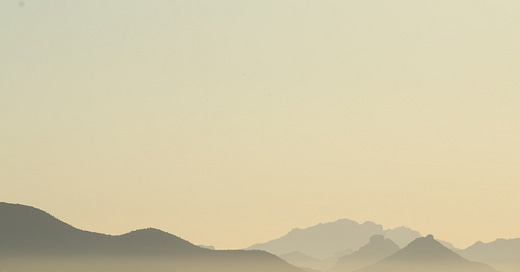




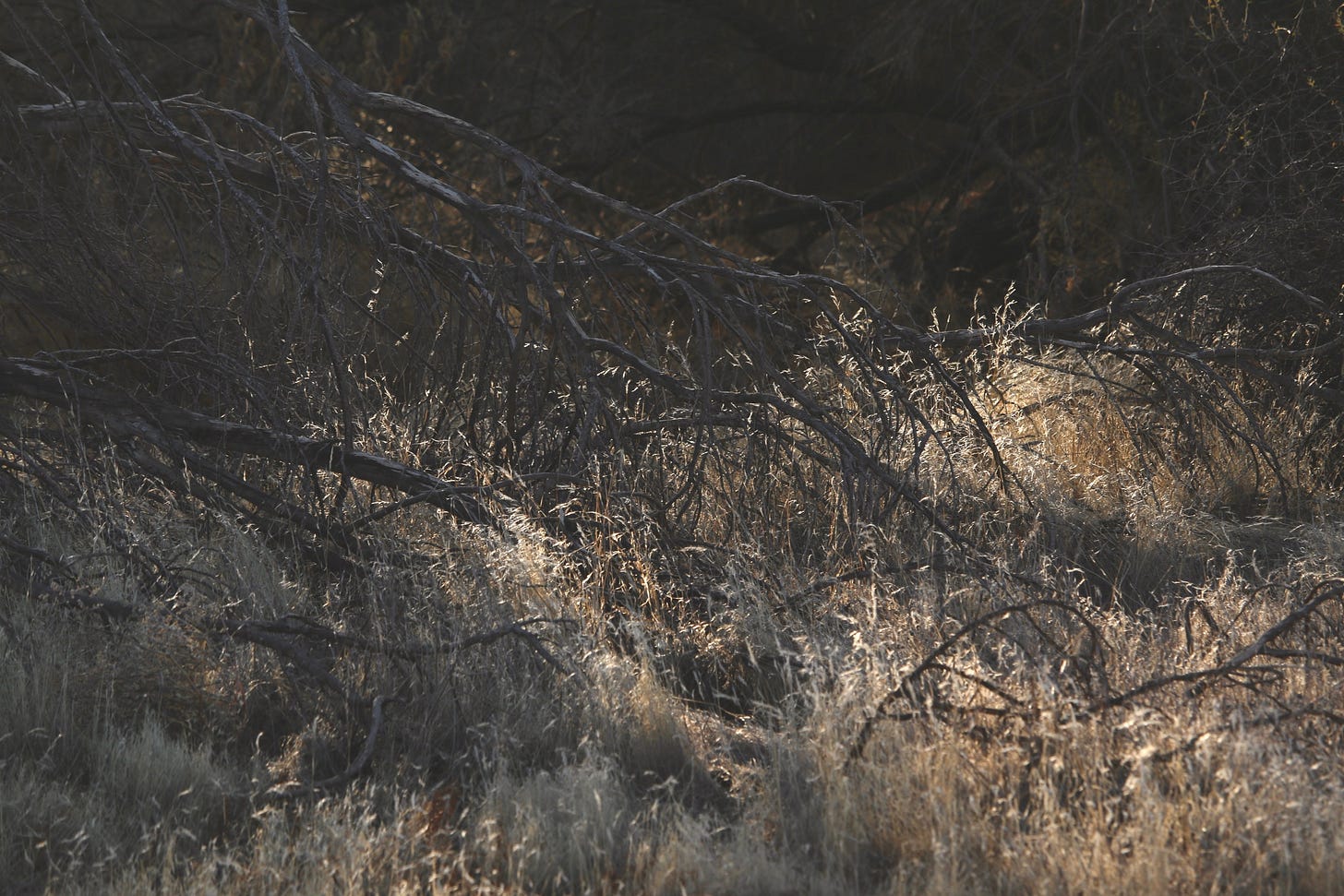
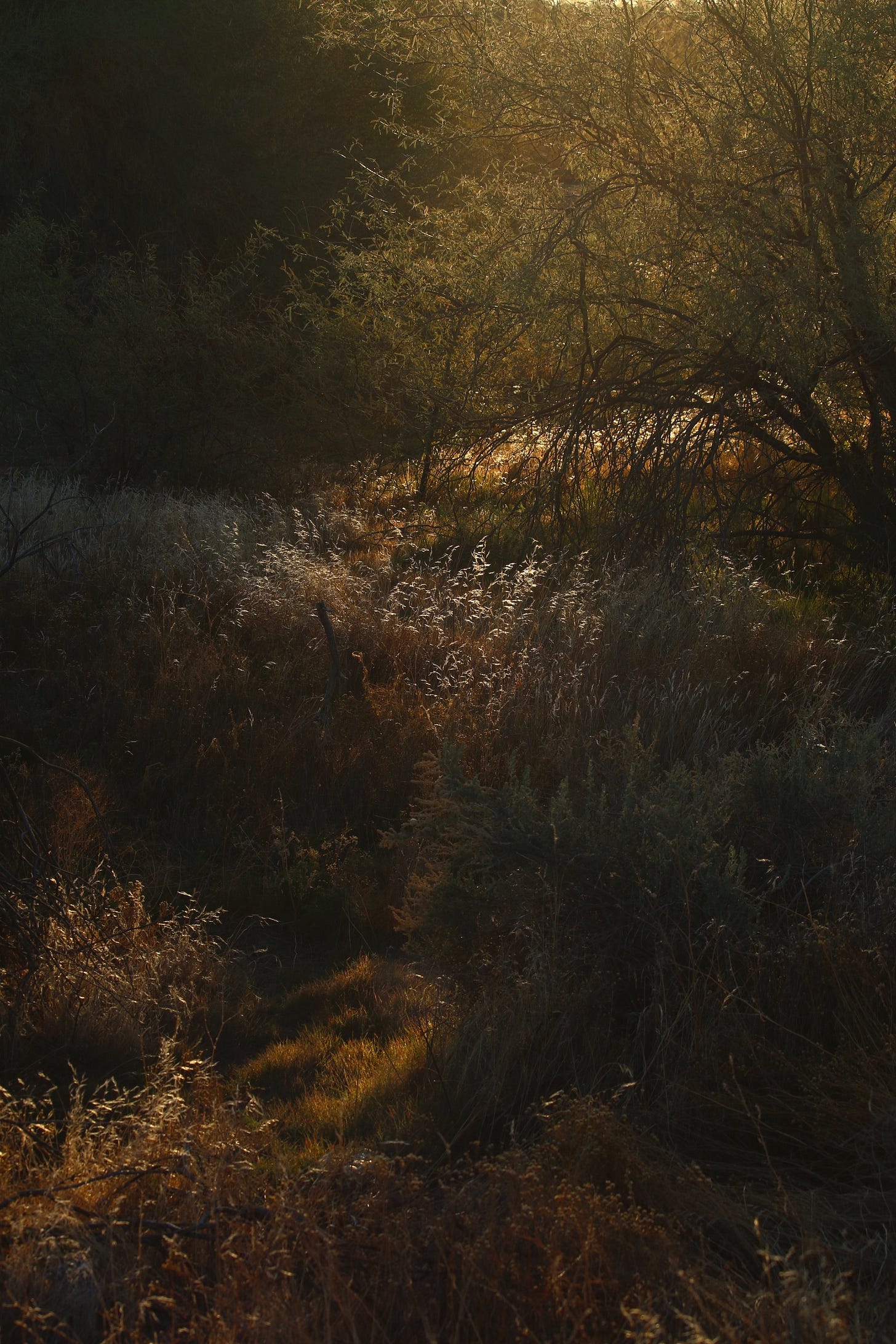
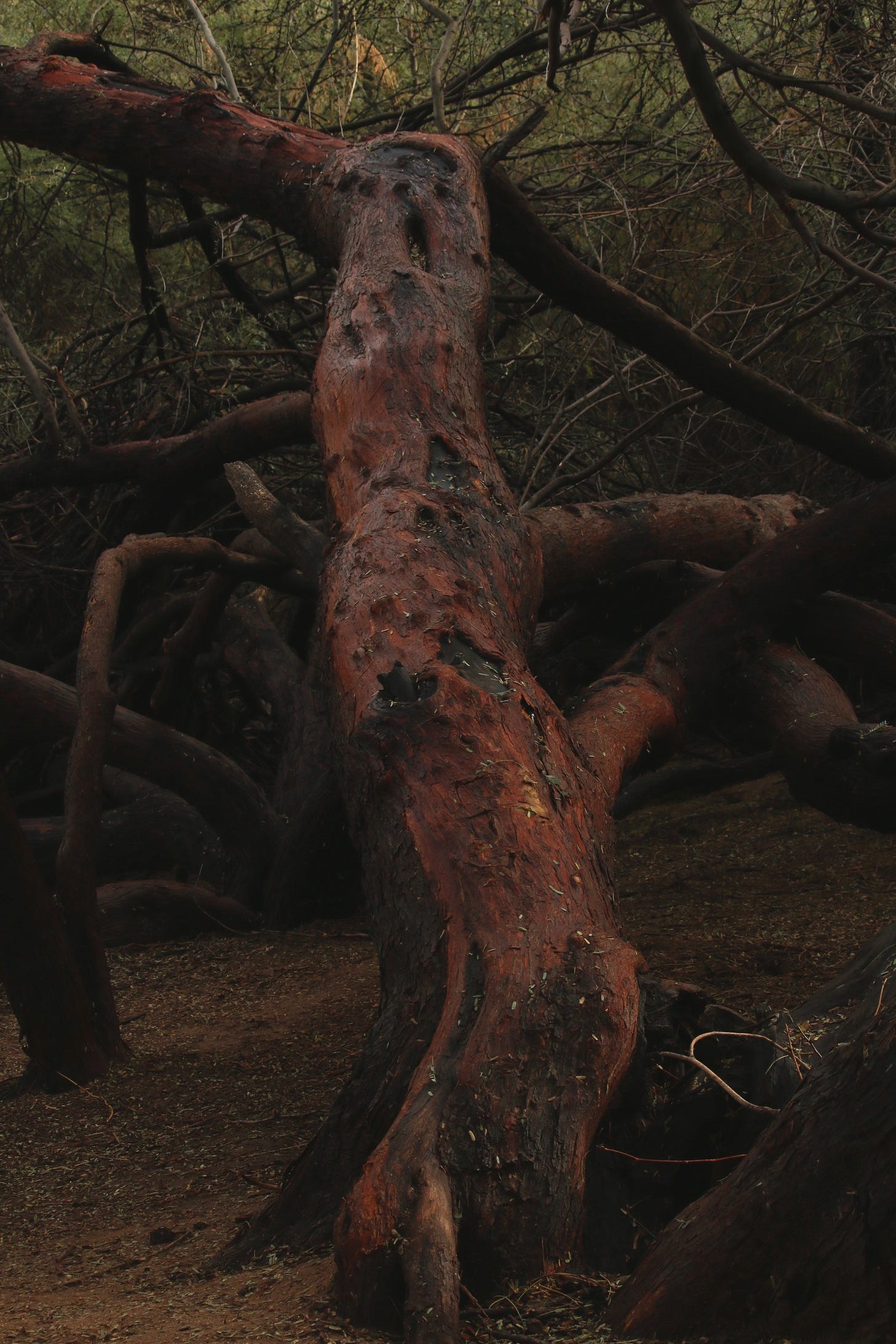
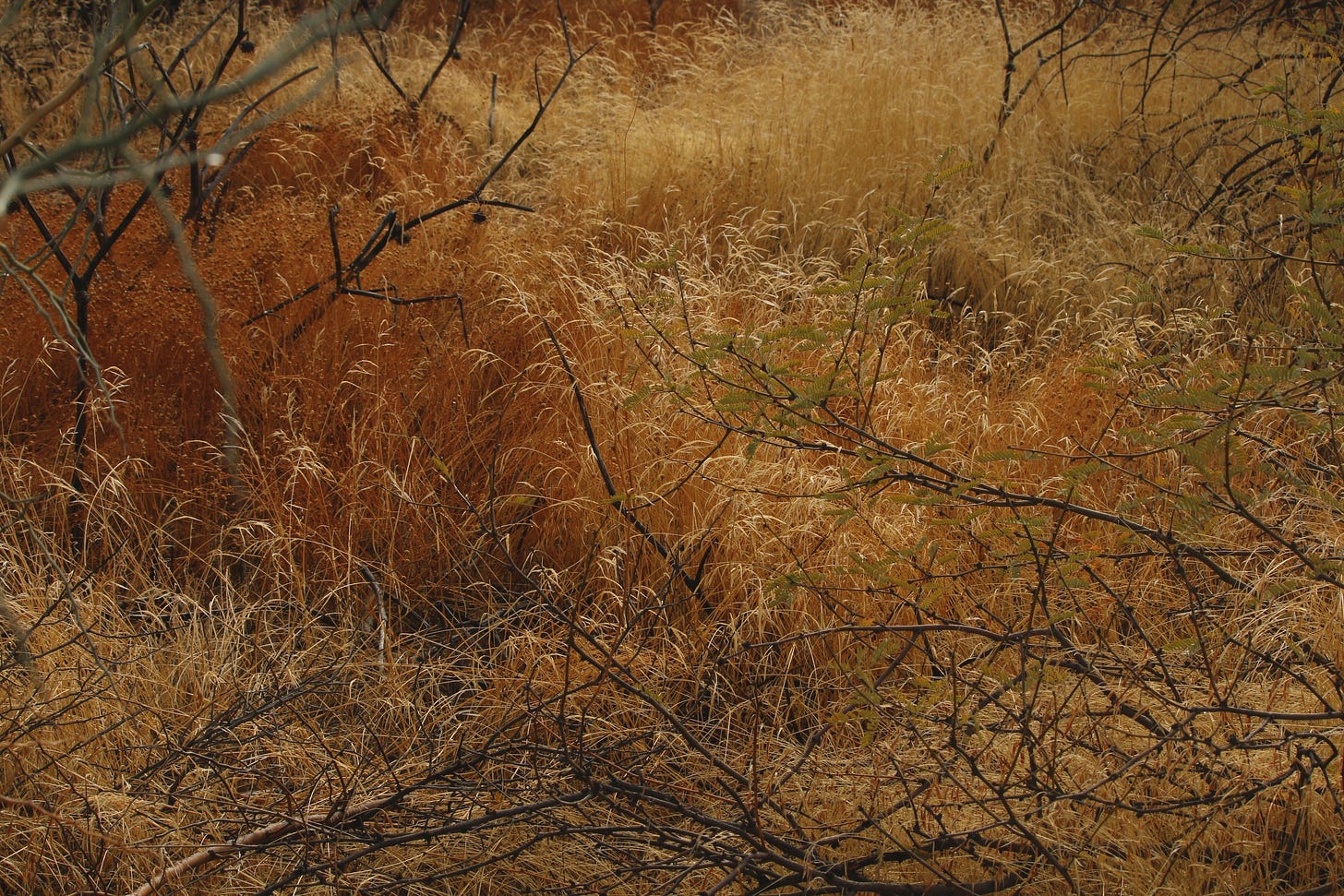

I am bowled over by this piece, and by your writing. It's impossible to absorb all the details properly in one read. I must read it again and then likely again.
Leslie! I loved this piece so much (and I want to frame that photo 4). Very swept up in the shifting perspective and all the colors and textures that compliment it. It makes me think of every time I return to Monroe, how my feelings towards it have shifted in surprising ways that I'm not entirely sure what to make of, but am interested in it nonetheless.